How to build a seismic grade 8 steel structure factory with rock wool panel?
In the 7.8-magnitude earthquake in Turkey in 2023, a large number of traditional concrete factories were reduced to ruins. After the 6.9-magnitude earthquake in Java, Indonesia in 2024, the repair cycle of brick-concrete industrial facilities lasted for half a year. These shocking cases are driving the transformation of industrial buildings in earthquake zones around the world towards lightweight, high toughness and rapid assembly. The deep integration of rock wool panel and steel structure is becoming the optimal solution for earthquake-resistant factory building construction with the triple advantages of safety, efficiency and sustainability.
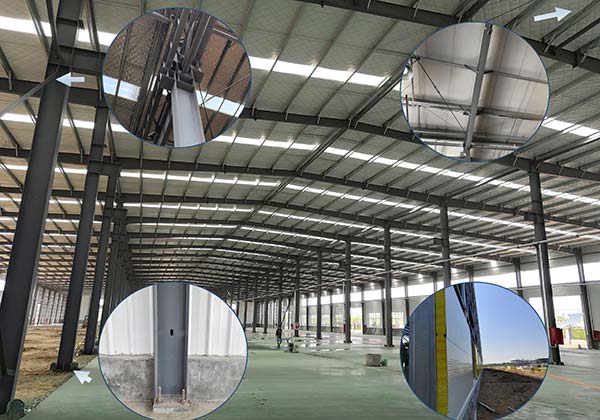
Ⅰ. Advantages of rock wool panel
Rock wool sandwich panel, an inorganic fiber board made of basalt as the main raw material through high-temperature melting, seems ordinary, but it plays a core supporting role in earthquake-resistant factories. Its advantages are:
1.1. Lightweight and high strength, reducing earthquake force
The essence of earthquake disasters is the destruction of buildings by inertial force. The greater the weight of the building, the stronger the earthquake force. The density of rock wool board is only 80-150kg/m³, which is about 1/10 of concrete. With the main body of steel structure, the overall weight of the structure can be reduced by more than 60%. Taking a 10,000㎡ factory building as an example, the total weight of rock wool panel and steel structure is about 1,200 tons, while the traditional concrete factory building requires more than 3,500 tons. The earthquake force is proportional to the deadweight, which means that the earthquake load borne by the former is reduced by nearly 2/3, which reduces the risk of structural damage from the root.
1.2. Toughness synergy, absorb earthquake energy
The steel structure itself has the characteristics of good ductility and high energy consumption, while the elastic modulus of rock wool panel (about 7-10GPa) and steel (about 200GPa) form a synergistic effect of rigidity and flexibility. When seismic waves cause displacement between structural layers, rock wool sandwich panels can absorb part of the energy through the slight deformation of the fiber layer, avoiding the steel structure from breaking due to local stress concentration. Experimental data show that in the shaking table test simulating a magnitude 8 earthquake (peak acceleration 0.3g), the maximum interlayer displacement angle of the steel structure factory filled with rock wool panels are only 1/200 (far below the standard limit of 1/100), and the structural integrity remains good.
1.3. Functional integration to improve comprehensive disaster resistance
In addition to earthquake resistance, rock wool sandwich panels also have A1-level fire protection, better combustion performance than concrete, thermal conductivity ≤0.04W/(m·K), thermal insulation performance is 3 times that of traditional brick walls, and water repellency ≥98%. In earthquake-prone areas around the world (such as the hot and humid climate of Southeast Asia and the high salt fog environment of the Pacific Rim), this feature can simultaneously solve the fire prevention, insulation, and moisture-proof needs of the plant, reducing the subsequent maintenance costs. It is estimated that the maintenance cost of the plant using rock wool panels over the entire life cycle is more than 30% lower than that of traditional plants.
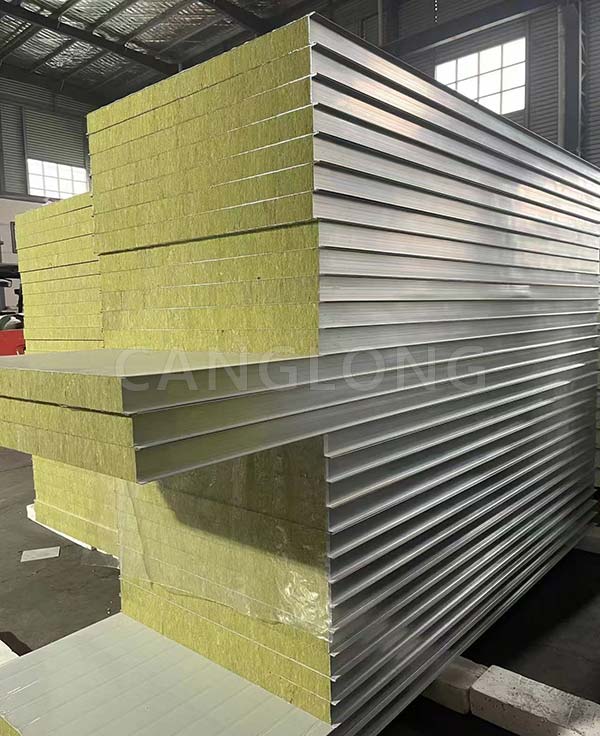
Ⅱ. Customization of solutions for earthquake zones
The geological conditions and seismic parameters (such as peak acceleration and spectral characteristics) of earthquake zones vary significantly, and the combination of rock wool panel and steel structures needs to be optimized in a targeted manner. The following are the adaptation strategies for the three major typical earthquake zones in the world:
2.1. Pacific Rim Seismic Belt (such as Japan, Chile, and New Zealand)
The peak acceleration of seismic motion in this area is generally ≥0.4g (above magnitude 8), and the proportion of short-period seismic waves is high (easy to cause local vibration of steel structures). The solution needs to focus on two points:
- Node reinforcement: Use a combination of rigid connection and energy dissipation devices. The connection between steel columns and steel beams uses 10.9-grade high-strength bolts and stiffening ribs to ensure the rigidity of the main frame. At the same time, metal yield dampers (such as soft steel dampers) are added to the beam-column nodes. During an earthquake, the dampers give priority to yielding and dissipating energy to protect the main structure.
- Rock wool panel upgrade: Use high-density rock wool boards (compressive strength ≥1.0MPa) with a density of 120kg/m³, and fill the board seams with silicone sealant to avoid thermal bridges or leakage caused by board displacement during an earthquake. In a Japanese automobile factory renovation project, after adopting this solution, the factory building only had slight cracks in the decorative layer in a magnitude 7.3 earthquake, and the main structure was not damaged.
2.2. Himalayan-Mediterranean seismic belt (such as southwest China, Nepal, Turkey)
The peak acceleration of seismic motion in this area is mostly between 0.3-0.5g, and the terrain is undulating (prone to uneven settlement). Key measures include:
- Flexible foundation treatment: pile foundation and rubber isolation bearings (such as lead rubber bearings LRB) are used to softly connect the upper structure to the foundation to isolate the upward transmission of seismic waves. In a factory building project in a chemical park in Yunnan, China, this technology was used to reduce the seismic force by 40%, and the displacement of the rock wool panel and the main steel structure in a magnitude 7.2 earthquake was only 5mm (far below the standard limit of 15mm).
- Rock wool board crack resistance design: Add a wire mesh polymer mortar layer (3-5mm thick) on the outside of the rock wool sandwich panel, use the mesh to enhance the bonding between the panel and the steel structure, and the expansion of the micro cracks in the mortar layer can absorb part of the earthquake energy to avoid large-scale shedding.
2.3. Continental internal fault zone (such as California, Northwest China)
The peak acceleration of seismic motion in this area is mostly 0.2-0.3g (about 7), but the epicenter is shallow and there are many aftershocks. The solution needs to balance safety and cost:
- Lightweight design: Use thin-walled H-shaped steel (section height 200-300mm) as the main frame, with 100kg/m³ low-density rock wool board (sufficient fireproof grade A1) to reduce material consumption. In a logistics warehouse project in Xinjiang, China, this solution saves 15% of the cost compared with traditional concrete structures and passes the 8-degree earthquake fortification verification.
- Modular assembly: Rock wool panels are pre-cut into standard modules in the factory and quickly fixed on site with self-tapping screws, reducing wet work on site and shortening the construction period by more than 30%. This is particularly important for areas with frequent aftershocks to avoid long-term exposure to secondary disaster risks.
Ⅲ. One-stop seismic solution from design to installation
The construction of factories in earthquake zones around the world requires not only innovation in materials and technology, but also professional services throughout the entire process. As an enterprise that has been deeply involved in the steel structure field for 20 years, Canglong Group relies on its integrated R&D, design, production and installation capabilities to provide customers with customized solutions for seismic-resistant factories of level 8.
3.1. Full-cycle design
Canglong Group uses seismic design software to automatically calculate key indicators such as structural stiffness, damping ratio, inter-layer displacement angle, etc. according to the seismic parameters of the project location (such as ASCE 7, GB 50011, and Japanese Building Standards Law), and optimize parameters such as rock wool apnel thickness, bolt spacing, and damper arrangement. For example, for a factory in a magnitude 8 earthquake zone in Chile, the team increased the density of the rock wool board from 100kg/m³ to 120kg/m³ through simulation verification, and adjusted the number of bolts at the beam-column node. The final solution passed the local seismic review at one time.
3.2. Factory production
Canglong Group has an 80,000 square meter intelligent factory equipped with CNC plasma cutting machines, automatic cotton spraying lines, and rock wool sandwich panel composite production lines, which can achieve:
Steel components: welding accuracy ±1mm, coating thickness uniformity deviation ≤5% (meet ISO 1461 standards).
Rock wool panel: density deviation ≤±5kg/m³, board surface flatness ≤2mm (meet GB/T 25975-2018). All materials must pass wind resistance tests (level 12 wind) and quasi-static seismic tests (simulating a magnitude 7.5 earthquake) before leaving the factory to ensure zero error in on-site installation.
3.3. Full-process installation
For the scenario of urgent reconstruction after the earthquake, Canglong Group launched a modular rapid installation process:
Foundation stage: prestressed pipe piles and adjustable anchor bolts are used to complete the foundation construction within 2 days.
Main stage: the steel frame is hoisted and bolted, and the installation of a single span (30m×24m) takes only 8 hours.
Enclosure stage: the rock wool panel is fixed by positioning fixtures and self-tapping screws, and the installation time of a single wall is ≤4 hours.
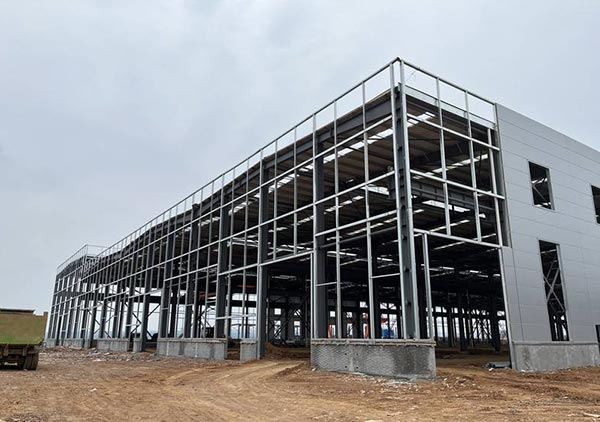
Ⅳ. Conclusion
From the ruins of the Turkish earthquake to the modern factory buildings in the Chilean mining area, from the humid rainforests of Indonesia to the industrial parks in the mountains of southwest China, the combination of rock wool panels and steel structure is redefining the safety boundaries of earthquake-resistant factories with its light and tough characteristics. Canglong Group’s one-stop service transforms this technical advantage into a feasible, replicable and reliable solution. Today, when the global earthquake risk continues to increase, this is not only a technological innovation of industrial buildings, but also a solemn commitment to the safety of life and property.
Choose rock wool panel and steel structure, choose Canglong Group, so that the factory can stand more steadily and last longer during earthquakes.
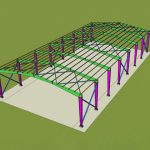
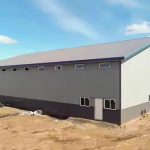
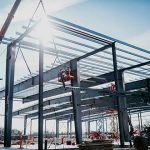
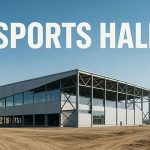
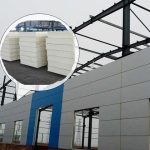
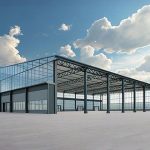
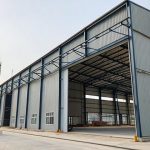
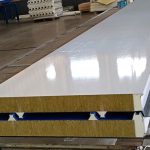
Send us the inquiry form